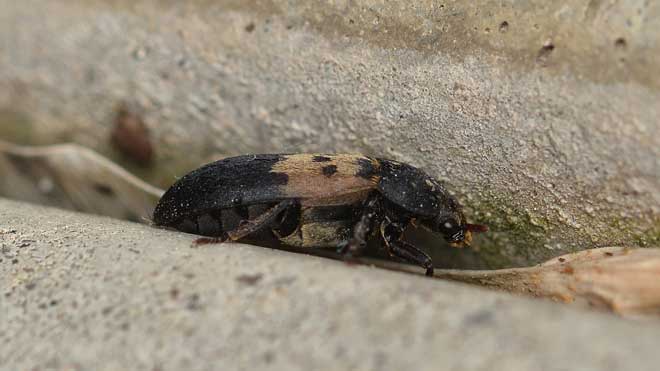Introduction
Larder beetle (Demestes lardarius) is a species of beetle in the family Dermestidae. It is is recognized as a commercial and household pest. For hundreds of years, larder beetle was notorious for infesting cured meats in Canada, Europe, and the United States. The advent of refrigeration, coupled with the purchase of meats in smaller quantities, significantly reduced the insect’s role as a commercial pest. The beetles are often found in locations containing accessible food sources. This can include households, market places, storage facilities, museums, mills, and other buildings. When larder beetles gather in abundance, they can cause significant damage to food and animal products.
Distribution & Habitat
Larder beetle is common across North America and Europe.
Hosts
Larder beetle larvae feast on cheese, dried meat, fish, pantry items, tobacco, insect carcasses, and animal by-products, such as furs, hides, horns, hair, and feathers. The insect is especially keen on grain, and pet food. The larvae will sometimes feed on bee and wasp nests.
Description
The adults are dark brown beetles that measure 1/3 to 3/8 of an inch in length. The beetles are oval-shaped. The abdomen and legs are laden with fine, yellow hair-like setae. The upper forewings are densely covered with coarse, pale yellow setae. The setae form a triangular band, with three to six dark spots in the center. The larvae range from red to dark brown in coloration. They are larger than the adults, measuring approximately ½ inch in length. The larvae have two distinct curved spines located on the final abdominal segment.
Life Cycle
Depending on the geographic location, larder beetle can produce one to six generations per year. A single generation can be completed in 40 to 50 days. The adults overwinter in bark crevices, buildings, and other sheltered places. In early spring, the adults resume activity, and bore out of their overwintering sites. The adults mate, with the males expiring shortly thereafter. The females each lay around 135 eggs in nearby food sources. Within 12 days, the eggs hatch, revealing masses of larvae.
The larvae immediately begin consuming any available food items. As the larvae feed, they rapidly increase in size. The males progress through five instars during their development. The females pass through six instars. Once mature, the larvae tunnel into wood and other materials, where they construct pupal chambers. The larvae settle within the pupal chambers, and commence pupation. The larvae pupate for 3 to 7 days. By the end of the pupal stage, the larvae morph into adults. The adults emerge from the pupal chambers. Once temperatures decrease in fall, the adults flock to protected areas to overwinter.
Symptoms of Infestation
The larvae can bore into nearly any item or structure containing food products. They can penetrate dense materials, such as lead, tin, wood, cork, and plaster, and softer items, including books, magazines, and insulation. Any food items that the larvae attack may be rendered inedible. In museums and historical sites, the adults and larvae can destroy preserved animal specimens or documents. As they feed, the larvae expel fecal pellets, which can accumulate where food has been stored.
Management
- Clean, inspect, and dispose of infested food sources.
- Infested materials can be sterilized with heat, or frozen.
- Place food items in jars, containers, or cans to discourage infestations.
- Examine areas where food is stored for the presence of the adults or larvae.
- Seal openings around buildings to deter the adults when they seek shelter.
- Residual pesticides can be applied to the exterior of buildings to combat the adults.
Photo courtesy of Ryan Hodnett CC-by-2.0


